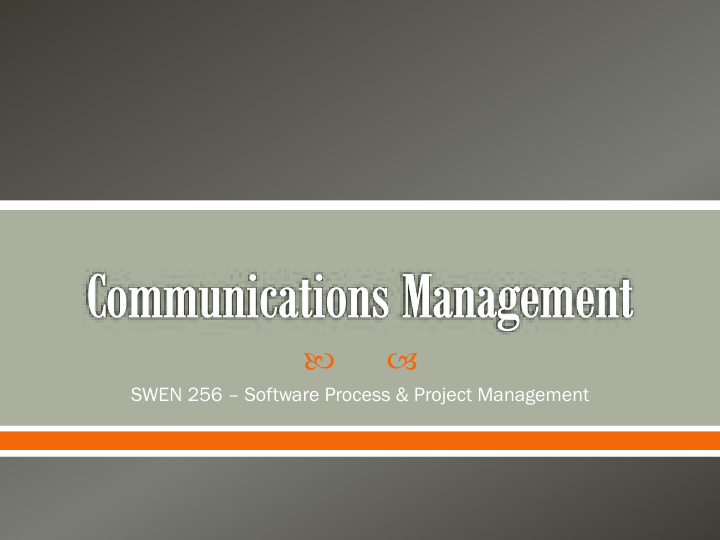



SWEN 256 – Software Process & Project Management
Internal External Formal Informal Vertical Horizontal Official Unofficial Written Oral Sender Receiver Verbal Nonverbal Open/Plain Paralingual Channel / Noise Technology? Meeting? From Who? Context?
Interactive vs. Push vs. Pull Communication Communication Channels # Communication N = the number 𝑂 𝑂 − 1 Channels of people 2 Communication Blockers • Obvious (Language, Culture, Noisy surroundings, Distance between parties) • Less Obvious (Improper encoding of messages, Negativity, Hostility)
Ideally … You would never need them Status would already be known Communications would be instantaneous, up-to-date and accurate But life seldom matches the ideal Daily scrum is a status meeting! Sprint demos are status meetings!
Some Good Ideas: Clear purpose and agenda announced beforehand Good advanced notice / Time limit for the meeting Regular but not too frequent Assign deliverables/action items from the meeting w/ clear time limits and distribution channels Document and publish meeting minutes
Consider: culture, expectations, technology, methods, established policies and procedures Plan to Communicate: Who, when, what channel, and with what frequency Plan to Communicate: What Type pe Ex Examples ples Project Documents Charter, PM Plan Schedule/Resources WBS, Resource needs, Meeting Schedule, Work Assignments (upcoming and current) Status General Status, Impacts to/from other projects, Performance Reports Risks New Risks, Uncertainties, Realized Risks (problems) Change Control Scope changes, CCB communications
As As a P PM M or or Tea eam m Me Member ber, , co communica munication tion is at the t the he heart t of of eth thical cal and ho d honest est beh ehavi vior or and res d responsibility ponsibility. Try to understand the truth o Be careful – your perception of the truth may be false o Seek the whole truth Be truthful in all communications o Communicate honestly, even if the project is in trouble Create an environment where others tell the truth o Telling the truth consistently lets project team members know that only the truth is acceptable
Discuss Only accept assignments you are qualified to complete o Lack of qualification presents a major risk to the project Protect proprietary information, Report unethical behavior and violations Maintain an attitude of mutual cooperation o Consider other projects and operational work when asking for resources o Protect reputations of your team members as it relates to project work o Ask what communication method is favored by your stakeholders/team Be direct in dealing with conflict o Openly discuss conflict with the other party, not behind their back Continuously look for conflicts of interest and disclose them o Treat the search and resolution of conflicts of interest like risks
Bes est Wh What ne need eds s to be be Res espo ponsibi sibilit ity for Wh When en / / H How w Why Wh Bet etwee een Wh Whom Commu mmunic icat ation ion Commu mmunic icat ated ed Sen endi ding Often en Met ethod
“Expectation Management”
1. Analyze Stakeholders continuously 2. Create and Maintain a Stakeholder Register 3. Create and execute a Stakeholder Management Strategy Stakeholder Register – Project Title: Project Number: Impac pact Depar artm tment ent(s (s) ) Contact t ID ID Name Title Major Main Ex- Influence Role(s) in Responsibilities /Super ervis visor or Info Classification Req’ts pectations (1-5) Project in Project 1 2
High Keep Satisfied Manage Closely Power Monitor (Min Effort) Keep Informed Low Interest High
Items that may need regular communication o Schedule, Budget, Forecasts o Risk Register, Issue Log, Change Log o Items outside of the control of the project that affect the project Involves the application of Communication Methods, Interpersonal Skills, and Management Skills to manage expectations of people important to the project.
Statu tatus s Rep epor ort t – Where is the project is against the performance measurement baseline? Progr ogress ess Rep epor ort t – What has been accomplished? Trend R rend Rep epor ort t – Is performance improving or deteriorating? For orec ecasting sting Rep epor ort t – What are the predictions for the future? Varia riance nce Rep epor ort t – How do the actual results compare to the baselines? Ea Earned rned Valu lue e Rep epor ort t – Where is the project in pure Earned Value/Cost Management terms? Le Lessons ssons Le Learned rned – What information could be useful for future projects?
Collecting information, analyzing it, packaging it, and sending it to Stakeholders. o Level of Detail o Appropriate communication channel o Don’t let reports prevent you from managing the project o Are measurements against a consistent baseline o Truthful with accurate metrics o All three sides of the project triangle plus quality o Can and should be enhanced with forecasts o Get feedback o Use multiple types of reports
Communication concepts must be applied to both stakeholder and team communication Communication is not effective unless it is ethical and honest Stakeholder Expectation Management starts with understanding each stakeholder, then concentrates on deciding what communication is best for them Make reports and metrics useful by viewing them from the Stakeholder’s perspective
Recommend
More recommend